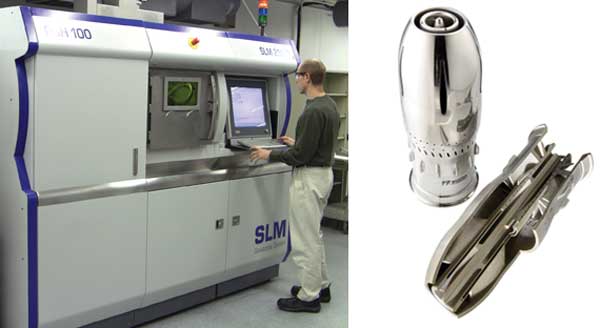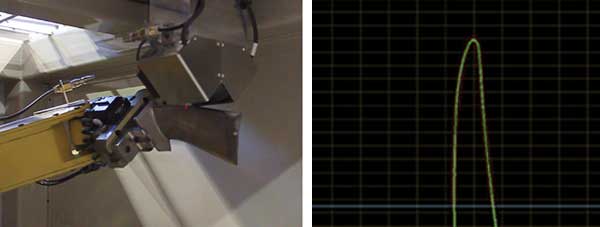
Photonics Helps Create Greener Airways
Laser and imaging technologies are helping aircraft manufacturers make their processes more eco-friendly.
White contrails in the sky could soon be tinged green, thanks to increased airplane efficiency brought about by manufacturing using lasers and imaging systems.
Lasers are taking weight out of components and ramping up performance, thereby boosting fuel efficiency and cutting carbon emissions; imaging systems are ensuring complicated airfoils are correctly made, raising engine efficiency.
It’s a good thing such advances are on the way, as the aviation industry faces looming demands for greater fuel efficiency. For instance, the Advisory Council for Aviation Research and Innovation in Europe has outlined various environmental objectives in its ACARE 2020 goals. Announced in 2001, some of these goals are aimed at reducing carbon emissions.

Laser-powered additive manufacturing systems (left) produce parts like this demonstration combustion tube with complicated internal shapes (right). The technique is making components for next-generation, more fuel-efficient jet engines. Photo courtesy of GE.
“The objective was to reduce fuel burn, or CO2 emissions, by half in 2020 versus 2000,” said Francis Couillard, general manager in charge of environmental affairs at Villaroche, France-based Snecma. The company partners with GE Aviation of Cincinnati to build jet engines that are among the most commercially successful in history.
The targets scheduled for 2020 are only the beginning. A follow-on goal announced in 2012 is to hit a 75 percent reduction in carbon emissions by 2050, again relative to 2000. At the same time, there are to be reductions in emissions of nitrogen oxides. All things being equal, fuel burn gets better as operating temperatures climb, but the production of nitrogen oxides tends to go up with temperature.
The industry is, therefore, seeking new answers. GE Aviation, for example, will be using a new approach: additive manufacturing. As the name implies, this technique creates components by adding material instead of removing it. In GE Aviation’s case, additive manufacturing is being applied to making fuel nozzles in its next-generation engines, which are slated to go into production in 2015.
Called the LEAP (Leading Edge Aviation Propulsion) engine, and being built in conjunction with Snecma, it will have up to 19 fuel nozzles. Additive manufacturing has allowed GE to replace what had been 20 different pieces within one fuel nozzle with just one part. The resulting component is five times more durable and also brings fuel efficiency improvements because it’s lighter.
“In the instance of our LEAP fuel nozzle, we have a 25 percent weight reduction,” said Eli Liechty, GE Additive Development Center plant manager.
“When we look at other components – some of the external components, the brackets, other hardware – we’ve run simulations where it’s possible to take 50 to 80 percent of the weight out of a component. There’s a tremendous opportunity to get a significant amount of weight out of these engines,” he added.

Compared with traditional methods, additive manufacturing could significantly reduce weight, as shown in an airplane hinge created conventionally (left) and through laser sintering additive manufacturing (right). Weight reductions of up to 80 percent are possible, helping reduce fuel burn. Photo courtesy of EOS.
This magic is possible because an additive process frees manufacturing from traditional constraints. In a conventional approach, a block of material would be processed so as to remove what’s not wanted. However, there are certain shapes – such as a fold in the interior wall of a tube – that cannot be produced this way.
Consequently, such shapes are either avoided altogether or, if they are used, are made by creating and then joining separate parts, which can be expensive.
In contrast, additive manufacturing as implemented by GE employs direct metal laser melting. Parts are constructed by laying down a 20-µm-thick coating of metal powder. Then a 200-W fiber laser supplies energy in a precise, computer-controlled pattern, fusing the powder into a thin layer. The manufacturing machine then lowers the part and puts down a new layer of powder, which it laser-bonds into place. The process repeats in this stepwise manner until the entire part is fabricated.
In addition to metallic parts, the technique can be – and has been – applied to plastic and other components. Among the advantages of the approach are reduced weight, improved reliability and freedom in designing parts.
One drawback is throughput. This is largely determined by laser power. GE is investigating the use of lasers that are up to 10 times the current wattage, Liechty said. If successful, that should translate into a tenfold improvement in output.
Another constraint is the size of the parts that can be constructed. At present, parts must measure less than 10 x 10 in. Research and development are under way into systems capable of constructing larger parts.
Many of the additive manufacturing systems being used at GE are from EOS, a privately held company based in Krailling, Germany. The systems originally were powered by CO2 lasers operating in the thermal IR, noted Andy Snow, regional director for EOS of North America. Around 2005, the company switched to near-IR fiber lasers operating at 1100 nm by IPG Photonics. This changed the materials that could be processed and considerably widened design choices.

An automated blade profiling system (left) uses a laser-based cloud-of-points sensor and software to determine an edge profile (right), with this finished as needed to achieve the right shape to maximize jet engine fuel efficiency. Photo courtesy of AV&R.
“If the material is weldable, then it can probably be laser-sintered,” Snow said.
Some of the most widely used applications of plastics in aviation additive manufacturing include the incorporation of flame-retardant nylons in serpentine ductwork in an aircraft’s fuselage. The new technology can cut processing costs. Also, simulations have shown that component weight reductions of 60 percent or more are possible, Snow said.
He noted that additive manufacturing has attracted considerable attention (see sidebar). For example, research and development are under way to develop high-temperature plastic additive manufacturing for defense and energy applications, Snow said.
While lasers are being used to get weight out of components, other photonic technologies are improving various aspects of aviation performance. One innovation involves the shape of rotating components in jet engines. Examples of such components include the large, visible fan blades seen on commercial jet engines and the much smaller ones found inside.
The leading and trailing edges of these rotating components play a key role in how air travels over them, with
a smoother and less turbulent flow contributing to higher overall efficiency and reduced fuel burn. A recent advance being deployed is the use of a carefully designed elliptical edge shape, which reportedly helps the latest Trent engines from Rolls-Royce of London to achieve more than a 1 percent fuel burn improvement over previous engines.
Verifying that those edges actually track the designed shape was formerly done manually, said Eric Beauregard, president and CEO of Montreal-based AV&R, which supplies robotic systems that automate edge profiling, polishing, and grinding and sanding, with this finishing process controlled via an adaptive visual inspection.
Getting the shape right does more than save fuel, according to Beauregard. It can also lead to a longer component life. That means an engine can spend more time on wing before being refurbished. During this repair and maintenance operation, achieving the right edge shape will again be important. AV&R systems do edge inspections with an off-the-shelf laser that generates a cloud of points, along with proprietary software, Beauregard noted.
The nature of the parts being inspected makes this challenging, he added. “These are metallic parts, and sometimes they have been polished before, so brilliance is an issue. Lasers have a big problem with that. When you’re looking at a leading edge, it’s a very round, small shape.”
Some of the algorithms in the company’s products were originally developed to speed up the visual inspection of space shuttle tile. Today, AV&R is moving from red to blue lasers in its systems, as shorter wavelengths enable a more discriminating inspection.
Currently, the aviation industry is transitioning from a 50- to 25-µm allowable deviation from the designed shape, Beauregard said. He noted that leading aviation companies have years of production from booked orders ahead of them. That means imminent delivery of new planes and engines, while manufacturing moves to tighter tolerances.
And photonics-based techniques will help to get them there. “The people in manufacturing need to reinvent themselves. They need to rethink the way they’re doing things,” Beauregard said.
Building up manufacturing
At the September 2012 International Manufacturing Technology Show in Chicago, additive manufacturing was featured as an emerging technology. The goal is to move it to “has arrived” status by 2014, said Scott Deutsch, a spokesman for the National Additive Manufacturing Innovation Institute in Youngstown, Ohio. He added that the ability to use more materials and the maturing of the technology are reasons why the technique is attracting interest.
The institute, a public-private partnership, receives federal funding. In early 2013, it announced $5 million in project grants aimed at applied research and development of additive manufacturing. That money could be well spent if proponents of the new approach prove right.
“We believe additive manufacturing will help define the future of US manufacturing,” Deutsch said.
As for what’s needed from lasers, Kevin Collier, plant manager for the institute’s factory, noted that greater power is beneficial. It raises throughput, expands the range of usable materials and improves the parts produced. For example, a power level of 40 W at a 12-m/s scan rate might result in weak plastic parts. The situation changes with the use of a higher power level of 52 W.
“You’ll get a much denser scan of that particular part, so it’s not a function of wavelength. It’s a function of power,” Collier said.
Published: September 2013